Unplugged: GamerDad Holiday Guide 2022
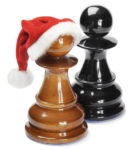 Happy Holidays! Boardgaming continues to make inroads to wider audiences, and there’s no better time to get (or get your friends and family) into the hobby than an extended holiday break. It is yet another “unusual” year so there may not be as much mixing in your neck of the woods but there are boardgames out there to meet up with almost any taste. If you only have access to online gaming buddies, check out BoardGameArena.com. Boardgames are timeless, just as good today as they will be years in the future, so a purchase today will still be serving you well after the lockdowns go away. As we at GamerDad have done for the past 18+ years, it’s time for an annual rundown of recent boardgames well worth your time. Feel free to delve into some past year’s guides for 2021, 2020, 2019, or older as they’re still great candidates for your consideration. You might not find all these titles at your local mega-mart but many can be found online or in a friendly local game store. Some may argue $60+ boardgames are expensive, but compare that to video gaming (and where multiple copies are required for multiplayer play) and the economics of boardgaming shows their true value. For each game I’ve provided the publisher (to help you find it), an approximate MSRP (you might find it lower), the number of players, the expected time for one game, and the manufacturer’s recommended ages. These age listings are often set for legal reasons and I would say most could easily be skewed lower for experienced younger gamers.
Happy Holidays! Boardgaming continues to make inroads to wider audiences, and there’s no better time to get (or get your friends and family) into the hobby than an extended holiday break. It is yet another “unusual” year so there may not be as much mixing in your neck of the woods but there are boardgames out there to meet up with almost any taste. If you only have access to online gaming buddies, check out BoardGameArena.com. Boardgames are timeless, just as good today as they will be years in the future, so a purchase today will still be serving you well after the lockdowns go away. As we at GamerDad have done for the past 18+ years, it’s time for an annual rundown of recent boardgames well worth your time. Feel free to delve into some past year’s guides for 2021, 2020, 2019, or older as they’re still great candidates for your consideration. You might not find all these titles at your local mega-mart but many can be found online or in a friendly local game store. Some may argue $60+ boardgames are expensive, but compare that to video gaming (and where multiple copies are required for multiplayer play) and the economics of boardgaming shows their true value. For each game I’ve provided the publisher (to help you find it), an approximate MSRP (you might find it lower), the number of players, the expected time for one game, and the manufacturer’s recommended ages. These age listings are often set for legal reasons and I would say most could easily be skewed lower for experienced younger gamers.
Games for and With Kids
Games suitable for kids old enough to sit still and play, but contain enough interesting activity to entertain adults.
Quacks & Co (Schmidt Spiele – $40) 2-4p 25 min 6+ yrs
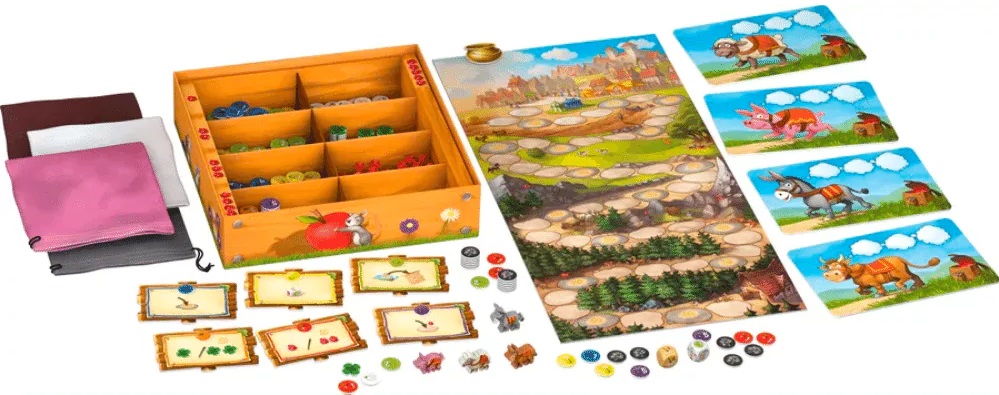 Quacks & Co takes the bag-building mechanics of award-winning Quacks of Quelinburg and slims the options down to a more kid-appropriate level. Players draw out numbered food-themed tokens from a bag, moving their animal along a path on the board based on the number on the marker. The first player to make it to the end of the path, wins. The interesting complexity of the game comes from the food makers. They come in various types and each type has a different game effect. Players start the game with a selection of tokens, including dream tokens. After three dream tokens are drawn, all a player’s tokens go back into their bag and they can buy new tokens to add to their bag. Hopefully these tokens have larger numbers and better or more interesting effects. Thus, the game accelerates at a nice pace with with animal tokens moving faster and farther towards the end. The special powers of the tokens can be changed from game to game, to provide further interest in the long haul. Quacks & Co is simple enough even for young kids to play, but there remain strategic choices to be made in when and which tokens to purchase.
Quacks & Co takes the bag-building mechanics of award-winning Quacks of Quelinburg and slims the options down to a more kid-appropriate level. Players draw out numbered food-themed tokens from a bag, moving their animal along a path on the board based on the number on the marker. The first player to make it to the end of the path, wins. The interesting complexity of the game comes from the food makers. They come in various types and each type has a different game effect. Players start the game with a selection of tokens, including dream tokens. After three dream tokens are drawn, all a player’s tokens go back into their bag and they can buy new tokens to add to their bag. Hopefully these tokens have larger numbers and better or more interesting effects. Thus, the game accelerates at a nice pace with with animal tokens moving faster and farther towards the end. The special powers of the tokens can be changed from game to game, to provide further interest in the long haul. Quacks & Co is simple enough even for young kids to play, but there remain strategic choices to be made in when and which tokens to purchase.
Flotsam Float (HABA – $40) 2–5p 15-20 min 6+
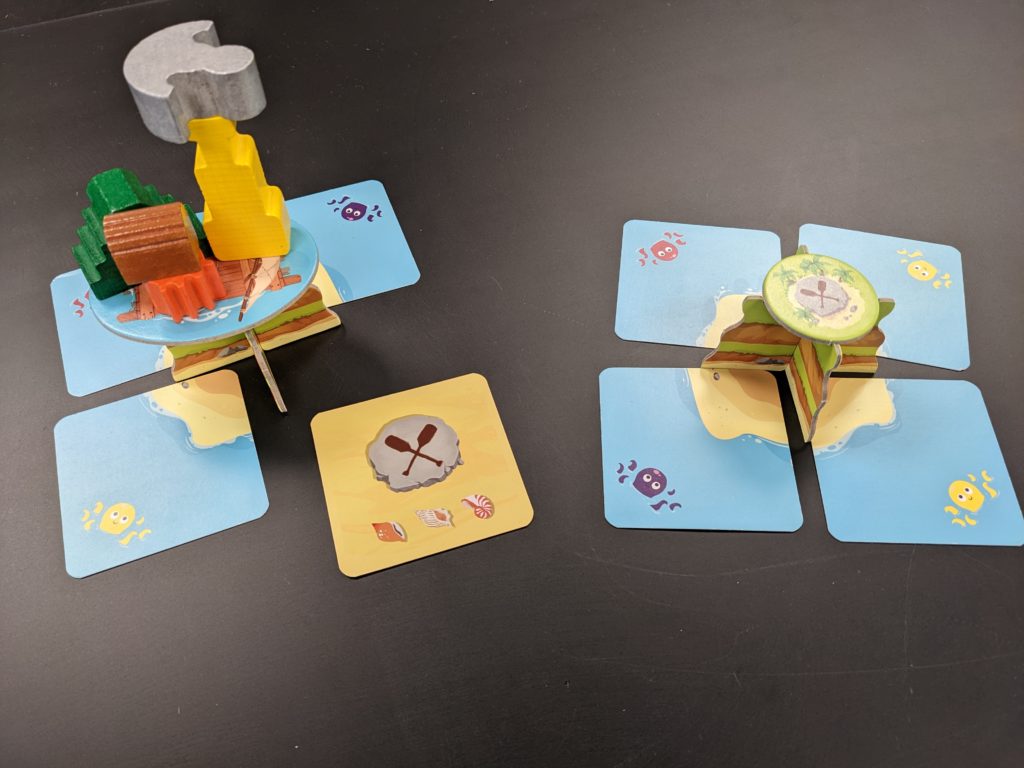 Flotsam Float is a dexterity stacking game where players place various nautical-themed wooden pieces onto an elevated platform in the shape of the a boat. What makes it stand out from the crowded dexterity field is that, once players place the next piece, they must move the entire stack to another location on the table. A successful stack & move grants a player a card showing a few shells on the back. Placing a piece especially high will sometimes award a bonus card. Once all pieces have been placed (possibly because they fell off and were set aside.) Players add up the shells on their cards to determine the winner. The pieces are quite varied – large & small, spikey & not – so there is often a decision to be made whether to place an “easy” piece to make sure you collect a card, or making a more difficult choice to try to make things hard for the next player. Of course, once placed, you still need to get that boat moved to its next location.
Flotsam Float is a dexterity stacking game where players place various nautical-themed wooden pieces onto an elevated platform in the shape of the a boat. What makes it stand out from the crowded dexterity field is that, once players place the next piece, they must move the entire stack to another location on the table. A successful stack & move grants a player a card showing a few shells on the back. Placing a piece especially high will sometimes award a bonus card. Once all pieces have been placed (possibly because they fell off and were set aside.) Players add up the shells on their cards to determine the winner. The pieces are quite varied – large & small, spikey & not – so there is often a decision to be made whether to place an “easy” piece to make sure you collect a card, or making a more difficult choice to try to make things hard for the next player. Of course, once placed, you still need to get that boat moved to its next location.
Dragomino (Blue Orange – $20) 2-4p 15 min 5+ yrs
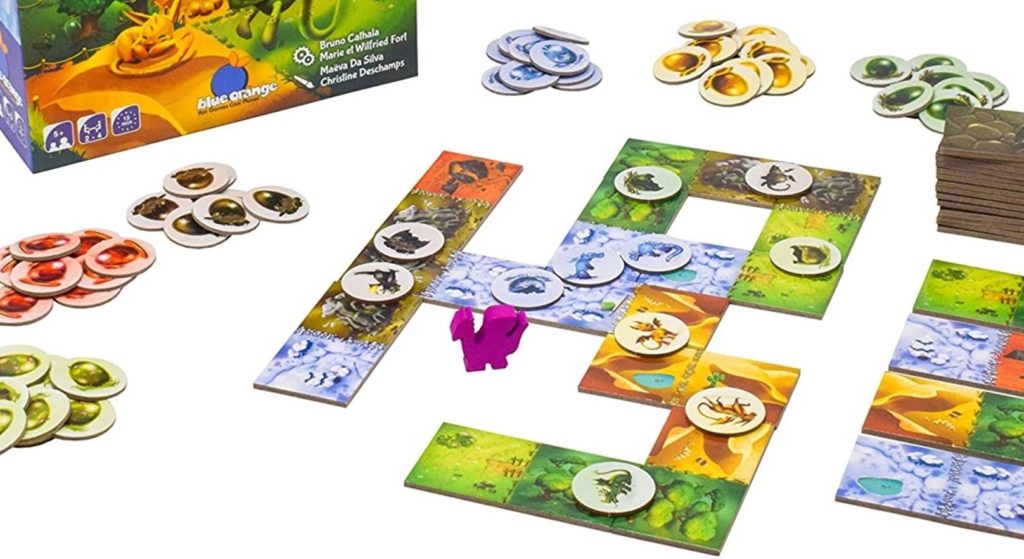 Winner of several awards in 2020-2021, Dragomino is a kid-friendlier version of Kingdomino (also a great, fairly lightweight family game.) Each round, four domino tiles (each side showing a landscape instead of a number) are placed in a tableau. Players draft a tile and add it to their personal landscape that they build. Placements that match nearby landscapes provide an extra egg tile which is placed where they join. These egg tiles award extra points or the shot at first pick for the next round. After seven rounds, players add up their final score to decide the winner.
Winner of several awards in 2020-2021, Dragomino is a kid-friendlier version of Kingdomino (also a great, fairly lightweight family game.) Each round, four domino tiles (each side showing a landscape instead of a number) are placed in a tableau. Players draft a tile and add it to their personal landscape that they build. Placements that match nearby landscapes provide an extra egg tile which is placed where they join. These egg tiles award extra points or the shot at first pick for the next round. After seven rounds, players add up their final score to decide the winner.
Party Games
The more, the merrier! Party games can accommodate at least 6 players and, unlike some games, tend to be more fun with more players. If you’re only aware of Charades (a classic) or Trivial Pursuit (only fun for know-it-alls) checking out some of these more engaging games will be a real treat.
Hues & Cues (The Op – $25) 3-10p 30 min 8+ yrs
 Not for the color-challenged, but Hues and Cues is a fun party game around guessing colors using verbal hints. The board is a two dimensional array of 480 standard colors. To play, one player draws a card and chooses one of four colors displayed on the card. They then provide a single word clue. Other players then place a marker on the board indicating the color picked by the clue-giver. Then follows a (one or) two word clue to help people guess. Once everyone has placed, a 3×3 score box is placed on the grid to show players’ points for the round. Picking the exact color awards several points, directly adjacent (still “in” the 3×3 box) is worth 2, and outside adjacent is worth 1 point. The clue-giver also scores points if players “guess” within the 3×3 grid. Not a thinker, for sure, but a great game for players who love colors (looking at you, dear) or are wanting to avoid “thinkier” guessing games.
Not for the color-challenged, but Hues and Cues is a fun party game around guessing colors using verbal hints. The board is a two dimensional array of 480 standard colors. To play, one player draws a card and chooses one of four colors displayed on the card. They then provide a single word clue. Other players then place a marker on the board indicating the color picked by the clue-giver. Then follows a (one or) two word clue to help people guess. Once everyone has placed, a 3×3 score box is placed on the grid to show players’ points for the round. Picking the exact color awards several points, directly adjacent (still “in” the 3×3 box) is worth 2, and outside adjacent is worth 1 point. The clue-giver also scores points if players “guess” within the 3×3 grid. Not a thinker, for sure, but a great game for players who love colors (looking at you, dear) or are wanting to avoid “thinkier” guessing games.
Ready Set Bet (AEG – $40) 2-9p 45-60 min 14+ yrs
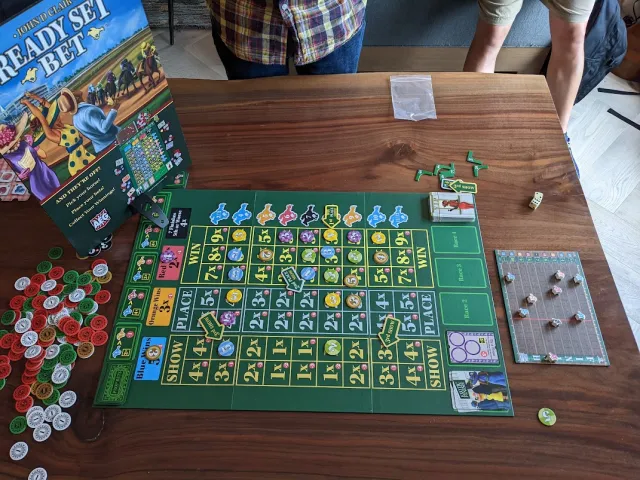 Ready Set Bet reimplemnets one of those carnival horse racing games as a dice-driven horse race on which players bet. One player serves as the caller, rolling two dice and moving wooden horse pieces that match the number rolled. If a number is rolled twice in a row, that horse gets an additional push along the line. It is hoped that the die roller narrates the entire process, hopefully with the stereotypical announcer voice. The game “board” is simply a grid of betting places where the rest of the players can place bets on how any individual horse performs. Bets can be placed for a horse to win, place (1st or 2nd), or show (1st-3rd) as well as a few wider bets on whether a category might win or lose. Bettting is real-time and players place their bet onto the board whenever they wish. Only one player per specific bet location, with payouts relative to the odds of a horse winning. Obviously, extra high and low numbers are less likely to win. Bets with the most probable payouts also incur a penalty on the bettor if they aren’t successful. Note, the betting is real-time so players can wait things out to see how the race pans out before betting, but then they miss out on the choicest spots. If no one gets into the spirit of the caller, there is an app that can serve as an announcer. The real-time nature of the betting keeps the game exciting, although late in the race the tension can dip a bit – which is when a fun and entertaining caller can keep things entertaining.
Ready Set Bet reimplemnets one of those carnival horse racing games as a dice-driven horse race on which players bet. One player serves as the caller, rolling two dice and moving wooden horse pieces that match the number rolled. If a number is rolled twice in a row, that horse gets an additional push along the line. It is hoped that the die roller narrates the entire process, hopefully with the stereotypical announcer voice. The game “board” is simply a grid of betting places where the rest of the players can place bets on how any individual horse performs. Bets can be placed for a horse to win, place (1st or 2nd), or show (1st-3rd) as well as a few wider bets on whether a category might win or lose. Bettting is real-time and players place their bet onto the board whenever they wish. Only one player per specific bet location, with payouts relative to the odds of a horse winning. Obviously, extra high and low numbers are less likely to win. Bets with the most probable payouts also incur a penalty on the bettor if they aren’t successful. Note, the betting is real-time so players can wait things out to see how the race pans out before betting, but then they miss out on the choicest spots. If no one gets into the spirit of the caller, there is an app that can serve as an announcer. The real-time nature of the betting keeps the game exciting, although late in the race the tension can dip a bit – which is when a fun and entertaining caller can keep things entertaining.
Special mention goes to Flotsam Float. Its listed as 2-5 players but I’ve seen groups of eight having a grand old time moving those pieces around. The more players, the more cheers and jeers to be had.
Family Games
As your family gets older, they’ll have more fun with games with a bit more “punch”. Games in this category are playable by most any age level (so even the young ones can participate) but have enough strategy so that the older players have a chance to use strategy to increase their chances of winning.
Marvel Dice Throne (The Op, Roxley – $50) 2-6*p 20-40 min 8+ yrs
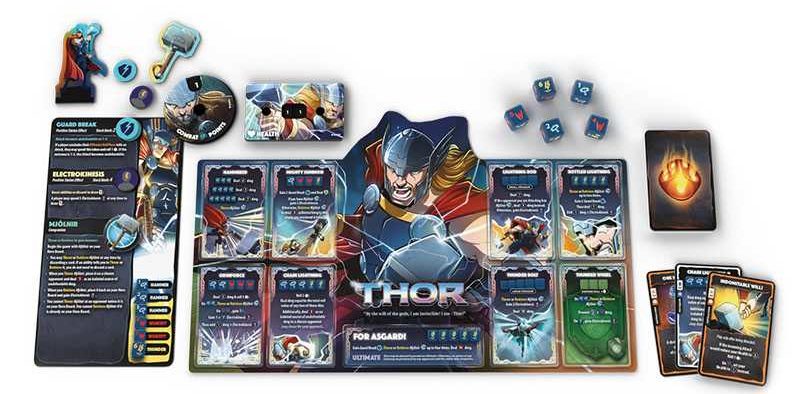 The simplest pitch for Marvel Dice Throne would be combat Yahtzee. Each player takes on a role of a different Marvel character. Players take turns attacking each other by rolling five dice three times, setting aside dice each time, if desired. At the conclusion of the roll, the dice trigger a power specific to that Marvel character. Rolling 4 of a kind, a full house, or a small or large straight will do damage, create an ongoing effect (good for you or bad for them), and often both. The more difficult the roll, the more powerful the effect. Your opponent then gets to roll a defensive roll. Rather than avoid any damage, it almost always retaliates with a small bit of damage and possibly more effects. Players also manage a hand of cards which are played by spending action resources. What makes each Marvel character unique are all those effects from a player’s playmat or deck of cards. Thor has a cardboard hammer they can toss at other players to do a single damage point, however they can later call it back and use that to draw extra cards. Not a huge swing in damage but very thematic of the character and quite satisfying. Loki gives you “presents” which create random effects, which are almost always bad – but can be good if Loki chooses (which he will when giving a present to a teammate or themself.) Marvel Dice Thrown is not deep strategy but it is a fun, quick (for those able to avoid bogging down with decisions) game with plenty of theme. The base game is $50 for four characters, with two 2-character packs of additional heroes for $30 each. The 2-character packs can be played on their own. Of note, this is a Marvel-themed expansion of the original Dice Throne game. While not cheap ($30 a pair of heroes or a complete set of 6 for $100) it can be played by itself or mixed with the Marvel Heroes. Most recently, Dice Throne Adventures ($80 expansion) was released and provides gamers a sort of cooperative dungeon-crawl experience using any of the released heroes (see its listing in Adventure games.)
The simplest pitch for Marvel Dice Throne would be combat Yahtzee. Each player takes on a role of a different Marvel character. Players take turns attacking each other by rolling five dice three times, setting aside dice each time, if desired. At the conclusion of the roll, the dice trigger a power specific to that Marvel character. Rolling 4 of a kind, a full house, or a small or large straight will do damage, create an ongoing effect (good for you or bad for them), and often both. The more difficult the roll, the more powerful the effect. Your opponent then gets to roll a defensive roll. Rather than avoid any damage, it almost always retaliates with a small bit of damage and possibly more effects. Players also manage a hand of cards which are played by spending action resources. What makes each Marvel character unique are all those effects from a player’s playmat or deck of cards. Thor has a cardboard hammer they can toss at other players to do a single damage point, however they can later call it back and use that to draw extra cards. Not a huge swing in damage but very thematic of the character and quite satisfying. Loki gives you “presents” which create random effects, which are almost always bad – but can be good if Loki chooses (which he will when giving a present to a teammate or themself.) Marvel Dice Thrown is not deep strategy but it is a fun, quick (for those able to avoid bogging down with decisions) game with plenty of theme. The base game is $50 for four characters, with two 2-character packs of additional heroes for $30 each. The 2-character packs can be played on their own. Of note, this is a Marvel-themed expansion of the original Dice Throne game. While not cheap ($30 a pair of heroes or a complete set of 6 for $100) it can be played by itself or mixed with the Marvel Heroes. Most recently, Dice Throne Adventures ($80 expansion) was released and provides gamers a sort of cooperative dungeon-crawl experience using any of the released heroes (see its listing in Adventure games.)
Dinosaur Island: Rawr ‘n Write (Pandasaurus Games – $30) 1-4p 30-45 min 10+ yrs
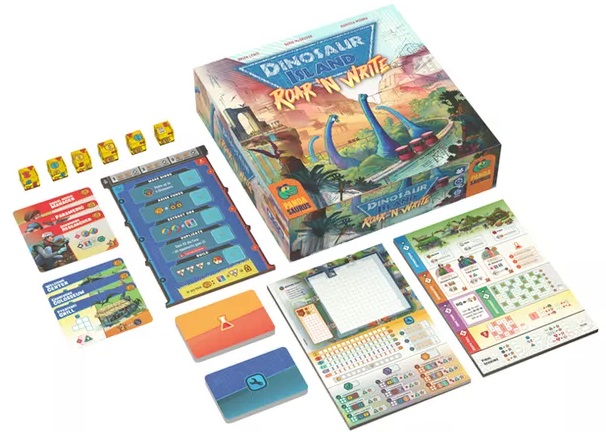 While not a direct tie-in it has all the feel of a running one’s own Jurassic Park. Players attempt to build the best dino theme park, tracking resources and buildings on their own tracker sheets. Players measure their success by scoring points via several different methods. Of course, most points come through building and filling up dinosaur pens. Someone rolls a set of special dice, and then players take turns drafting them in order to use their special abilities to gain DNA (to make dinos) or money (to build buildings or hire help.) These dice are then used to take actions to make those purchases. Whatever you construct (other than hiring help) needs to be drawn on a player’s personal park grid in sort of a Tetris style. However, no two buildings can touch each other. Players also construct roads between their “Tetris” buildings and three times during the game a virtual “tour” is run, scoring bonus points and resources along the way. Many actions in the game are simultaneous, which keeps the game moving at a fast pace. Even though the game revolves around rolling dice and drawing boxes on a grid, it manages to provide the feeling of running your own dino amusement park.
While not a direct tie-in it has all the feel of a running one’s own Jurassic Park. Players attempt to build the best dino theme park, tracking resources and buildings on their own tracker sheets. Players measure their success by scoring points via several different methods. Of course, most points come through building and filling up dinosaur pens. Someone rolls a set of special dice, and then players take turns drafting them in order to use their special abilities to gain DNA (to make dinos) or money (to build buildings or hire help.) These dice are then used to take actions to make those purchases. Whatever you construct (other than hiring help) needs to be drawn on a player’s personal park grid in sort of a Tetris style. However, no two buildings can touch each other. Players also construct roads between their “Tetris” buildings and three times during the game a virtual “tour” is run, scoring bonus points and resources along the way. Many actions in the game are simultaneous, which keeps the game moving at a fast pace. Even though the game revolves around rolling dice and drawing boxes on a grid, it manages to provide the feeling of running your own dino amusement park.
At-Home Escape Rooms
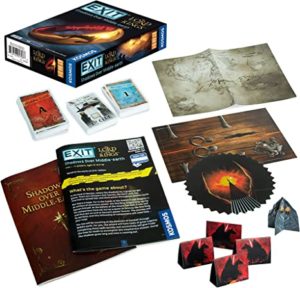
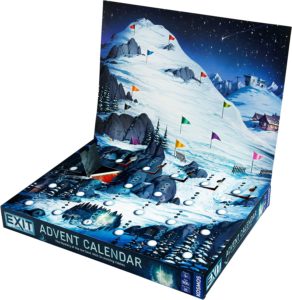
Each year I point out the various “escape room in a box” lines of games that can be had. Games of note for this year include Exit: The Game – The Lord of the Rings: Shadows over Middle-earth, a nice themed puzzle for fans of the series and a (probably too late for you now, but think of next year) an advent calendar also based on the Exit series. I’m working through Exit: The Game – Advent Calendar: The Mystery of the Ice Cave with my son and we’re having a great time opening up one compartment a day and solving that day’s puzzle. Eventually, items from earlier days will also be required as well as one final combination-puzzle when the holiday finally arrives.
Family Strategy Games
These are great games for most families – or a group of adults looking for a medium-weight game to play casually around the table to end an evening. These are a notch up in complexity kid’s or party games, but are simple enough for teens or preteens to enjoy.
Dice Realms (Rio Grande Games – $90) 2-4p 45-60 min 14+ yrs
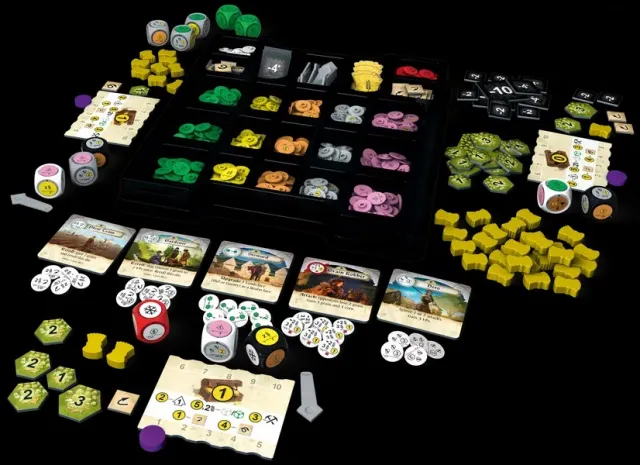 If you ever dreamed of a civilization-building game, but wanted to do it with dice, look no further than Dice Reams. The game uses special dice with removable faces. Players begin with two dice with rather unremarkable faces which grant points, resources, and powers but they may then upgrade those faces to more powerful abilities as the game progresses. Players may even purchase additional dice if they can pay for them. Be careful, all dice must be “fed” with grain (a resource available on some dice sides) or be penalized. All this would be only moderately remarkable, except the game comes with 35 different sets of faces, of which five are randomly chosen per game. Most games will rely heavily on the basic types of faces (food, upgrades, money, points) but those extra five choices will put a unique spin on almost every game. Once again, a somewhat bigger budget game in the list but one with a huge amount of variety every game (and variety not based around some legacy system….)
If you ever dreamed of a civilization-building game, but wanted to do it with dice, look no further than Dice Reams. The game uses special dice with removable faces. Players begin with two dice with rather unremarkable faces which grant points, resources, and powers but they may then upgrade those faces to more powerful abilities as the game progresses. Players may even purchase additional dice if they can pay for them. Be careful, all dice must be “fed” with grain (a resource available on some dice sides) or be penalized. All this would be only moderately remarkable, except the game comes with 35 different sets of faces, of which five are randomly chosen per game. Most games will rely heavily on the basic types of faces (food, upgrades, money, points) but those extra five choices will put a unique spin on almost every game. Once again, a somewhat bigger budget game in the list but one with a huge amount of variety every game (and variety not based around some legacy system….)
Starship Captains (Czech Games Edition – $60) 1-4p 40-100 min 12+
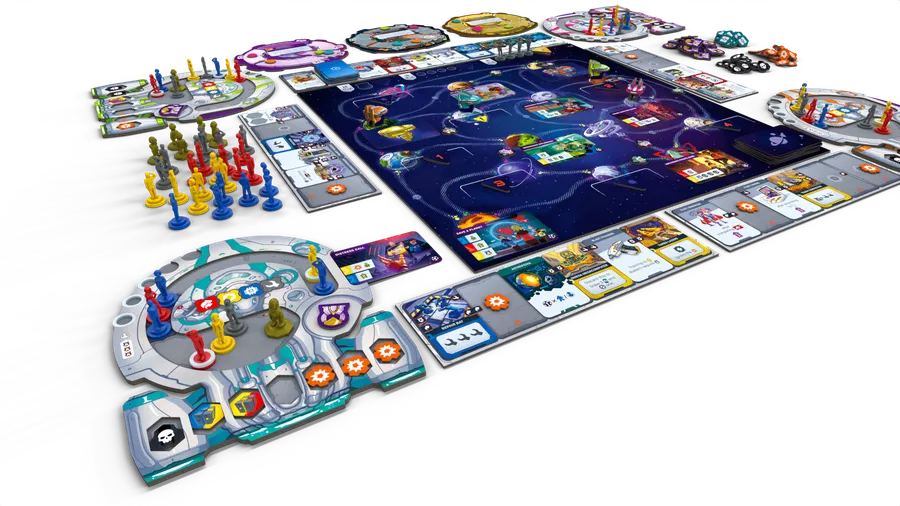 Just released, and while Starship Captains isn’t “official” canon, there are strong Trek overtones to the game. Players place crew markers of colors (surprise) red, yellow, and blue into rooms of their ship in order to trigger actions (this is often called worker-placement in boardgame terminology.) These actions include upgrading one’s ship (possibly adding rooms), upgrading and expanding one’s crew, exploring the galaxy, etc… Each activity tends to score victory points. The variety of strategic options (and variable game setup) means no two games will be quite alike. There are no direct Trek references, but many game systems (like the colors) and themes will resonate with a Trekkie. It is a solid game on its own, but a particularly nice one for fans.
Just released, and while Starship Captains isn’t “official” canon, there are strong Trek overtones to the game. Players place crew markers of colors (surprise) red, yellow, and blue into rooms of their ship in order to trigger actions (this is often called worker-placement in boardgame terminology.) These actions include upgrading one’s ship (possibly adding rooms), upgrading and expanding one’s crew, exploring the galaxy, etc… Each activity tends to score victory points. The variety of strategic options (and variable game setup) means no two games will be quite alike. There are no direct Trek references, but many game systems (like the colors) and themes will resonate with a Trekkie. It is a solid game on its own, but a particularly nice one for fans.
Terra Nova (Capstone Games – $55) 2-4p 60-90 min 12+
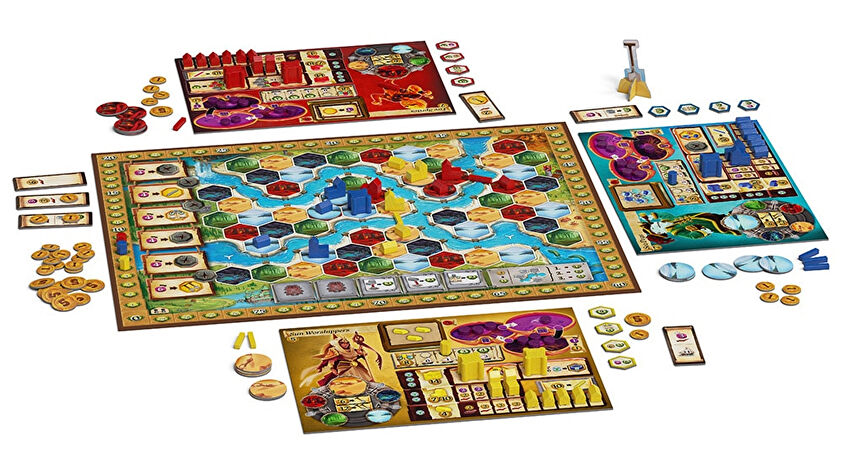 I’m a fan of the fairly complex game, Terra Mystica, but rarely get it to the table. Terra Nova takes much of what I like about the game and makes it more approachable for more strategic family game crowd. Each player is given a unique faction (out of 10) that is tied to one of five types of terrain. During the game, players try to place buildings onto the board and upgrade them over time. Placed buildings come from a player’s personal stock and each building type provides a special benefit. The lowest type provides money while the next level up provides power. Upgrading one more further level lets a player place one of two buildings that are unique to their faction, granting special abilities. These often dovetail with a faction’s starting special abilities. These include making things easier to place buildings, extending one’s adjacency rules, or simply improving one’s resource income. When placing a new building, it needs to be adjacent to a prior building and must be placed on the correct faction terrain. Players must first spend resources to convert the terrain to a friendly one. Building or upgrading next to an opponent’s buildings will grant them extra power. Power is the unique currency in the game. It travels through three pools. When a player gains power, first all power in the lowest pool is upgraded to the middle pool. Then power in the middle pool can get upgraded to the top pool. Only power in the top pool can be “spent” for extra actions or resources. However, spent power goes back down to the first pool and must be promoted to the second pool again before any more is added to the top pool. The actual practice is rather easy to understand once play begins. Scoring depends on final building positions, but there are five rounds in the game and each round has a special scoring rule (chosen randomly from a stack) which provides extra points for specific actions. With such a short game, players need to pay attention and satisfy at least a few of those conditions over the course of the game if they hope to win. Overall, the game can be compared somewhat to Catan with no real trading but with the addition of special faction powers. Despite the long description, Terra Nova could be favorably compared to Catan’s depth and time of play.
I’m a fan of the fairly complex game, Terra Mystica, but rarely get it to the table. Terra Nova takes much of what I like about the game and makes it more approachable for more strategic family game crowd. Each player is given a unique faction (out of 10) that is tied to one of five types of terrain. During the game, players try to place buildings onto the board and upgrade them over time. Placed buildings come from a player’s personal stock and each building type provides a special benefit. The lowest type provides money while the next level up provides power. Upgrading one more further level lets a player place one of two buildings that are unique to their faction, granting special abilities. These often dovetail with a faction’s starting special abilities. These include making things easier to place buildings, extending one’s adjacency rules, or simply improving one’s resource income. When placing a new building, it needs to be adjacent to a prior building and must be placed on the correct faction terrain. Players must first spend resources to convert the terrain to a friendly one. Building or upgrading next to an opponent’s buildings will grant them extra power. Power is the unique currency in the game. It travels through three pools. When a player gains power, first all power in the lowest pool is upgraded to the middle pool. Then power in the middle pool can get upgraded to the top pool. Only power in the top pool can be “spent” for extra actions or resources. However, spent power goes back down to the first pool and must be promoted to the second pool again before any more is added to the top pool. The actual practice is rather easy to understand once play begins. Scoring depends on final building positions, but there are five rounds in the game and each round has a special scoring rule (chosen randomly from a stack) which provides extra points for specific actions. With such a short game, players need to pay attention and satisfy at least a few of those conditions over the course of the game if they hope to win. Overall, the game can be compared somewhat to Catan with no real trading but with the addition of special faction powers. Despite the long description, Terra Nova could be favorably compared to Catan’s depth and time of play.
Adventure Games
Boardgames with a strong role-playing look and feel continue to flourish in the boardgame world. Perfect for gamers who want that role-playing feel without having to dedicate the dozens of hours needed to play traditional pencil and paper RPGs. These games run the gamut from simple and inexpensive to detailed and very expensive. Here is a sample cross-section.
Tiny Epic Dungeons (Gamelyn Games – $35) 1-4p 30-60 min 14+ yrs
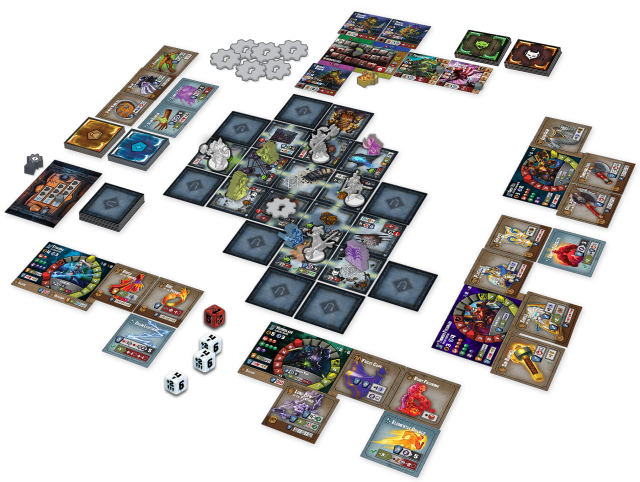 The Tiny Epic line of games is a great series of a wide variety of games with different themes and styles all packed into the same-size small gaming box. They’re great for a more budget-minded gamer. Tiny Epic Dungeons is one of the best in the series. It captures the essence of an RPG or video game dungeon crawl in a relatively quick game. Players choose a character to start on an initial tile. They then take turns exploring the dungeon by flipping over new tiles to discover what is underneath. This could be a challenge – attempted with one of three ability types – or a monster. Players fight off monsters (and challenges) with a special set of dice. The dice present an interesting decision point. High rolls are great for damage, but lower rolls have the option of adding to the high roll, or being used as a primary source of regaining energy. Most character special abilities key off of energy, and they can also be spent to modify die rolls. After exploring most of the dungeon, players will reveal the final boss (one of several possible ones) and a huge final battle will ensue. Hopefully, the players have gathered up good equipment from their travels and battles which are going to be needed to defeat the boss. Perhaps my favorite feature of the game are the various sets of equipment. Some equipment comes in sets and as a character collects more of that set they gain additional bonuses. Managing to collect at least one full set in the group is highly recommended before taking on the final boss.
The Tiny Epic line of games is a great series of a wide variety of games with different themes and styles all packed into the same-size small gaming box. They’re great for a more budget-minded gamer. Tiny Epic Dungeons is one of the best in the series. It captures the essence of an RPG or video game dungeon crawl in a relatively quick game. Players choose a character to start on an initial tile. They then take turns exploring the dungeon by flipping over new tiles to discover what is underneath. This could be a challenge – attempted with one of three ability types – or a monster. Players fight off monsters (and challenges) with a special set of dice. The dice present an interesting decision point. High rolls are great for damage, but lower rolls have the option of adding to the high roll, or being used as a primary source of regaining energy. Most character special abilities key off of energy, and they can also be spent to modify die rolls. After exploring most of the dungeon, players will reveal the final boss (one of several possible ones) and a huge final battle will ensue. Hopefully, the players have gathered up good equipment from their travels and battles which are going to be needed to defeat the boss. Perhaps my favorite feature of the game are the various sets of equipment. Some equipment comes in sets and as a character collects more of that set they gain additional bonuses. Managing to collect at least one full set in the group is highly recommended before taking on the final boss.
Dice Throne Adventures (Roxley – $80) 1-4p 90-120 min 8+
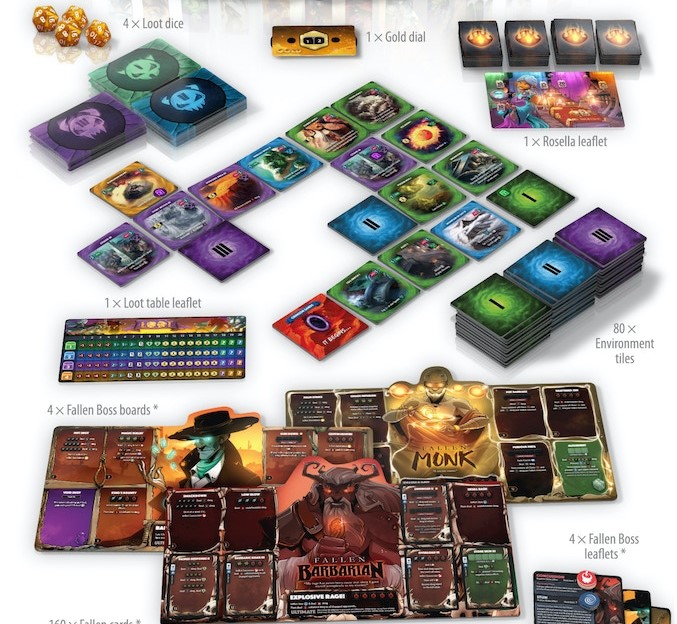 Mentioned briefly in the Marvel Dice Throne entry, I wanted to point out this expansion which changes the Dice Throne formula into a cooperative adventure. Players once again take on the persona of a particular hero or villain and then join together in a two part adventure. In part one, players explore a set of tiles, encountering monsters to fight and treasures to be had. Specific spaces must be visited in order to unlock the final Portal space. At the end of the exploration, players should have accumulated some gold and equipment. Players can then go “shopping” with their gold and kit out their character for the next stage – the boss battle. In the boss battle, players combine their abilities, taking turns to try to defeat the (automated by game rules and cards) extra-powerful boss. It’s a fun co-operative (or solo) option for gamers looking for more ways to play with their Dice Throne (Marvel or otherwise) characters.
Mentioned briefly in the Marvel Dice Throne entry, I wanted to point out this expansion which changes the Dice Throne formula into a cooperative adventure. Players once again take on the persona of a particular hero or villain and then join together in a two part adventure. In part one, players explore a set of tiles, encountering monsters to fight and treasures to be had. Specific spaces must be visited in order to unlock the final Portal space. At the end of the exploration, players should have accumulated some gold and equipment. Players can then go “shopping” with their gold and kit out their character for the next stage – the boss battle. In the boss battle, players combine their abilities, taking turns to try to defeat the (automated by game rules and cards) extra-powerful boss. It’s a fun co-operative (or solo) option for gamers looking for more ways to play with their Dice Throne (Marvel or otherwise) characters.
Return to Dark Tower (Restoration Games – $190 yes $190) 1-4p 100-120 min 10+
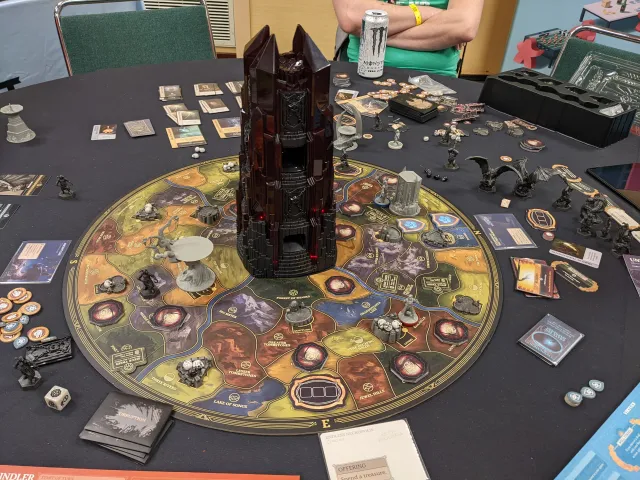 The priciest game on the list, this is an expensive labor of love for the old 80’s game with a huge, talking black tower in the middle of the board. Here, the over-engineered central tower connects with an app over bluetooth and is used as the central feature of an adventure game. Players move around the circular board fighting monsters and completing quests. Meanwhile the app keeps track of quests and adds new monsters to the board at the end of a player’s turn. Frequently, the tower will spin causing the skulls inside (one is added at the end of every turn) to rattle onto the play field. These collect in specific buildings on the board and if they ever overflow, bad things happen – bad enough that you might just lose the game. Therefore, one frequent activity is to try to remove skulls to stay ahead of things. Eventually, the players will fulfill the main quest which unlocks a final quest/battle against the main villain for that specific game. Defeat the villain before all the other bad things happening overwhelm the team and you win the game. Key to the game is the app (iOS, Android, PC, Mac, etc… with all the source code released so there’s no worry of it going out of date.) It handles generation of quests, combat, and other events. Combat consists of a player drawing cards in sequence, forcing a player to pay the shown cost or to spend one or more “advantages” to reduce the penalty on the card. (Note, advantages are typically not consumed and can be used again in later turns.) In some battles (particularly in dungeons) one can spend enough advantages to turn a card from a penalty to a bonus in resources. This “advantage” mechanism is key to players’ long-term plans. Every monster type (three chosen for each game) and boss is susceptible to two types of advantages. It is extremely expensive to go into a fight without a few advantages of the correct type. Each boss not only fights in a unique way, but it also affects how the entire game progresses. The spore-based one slowly eats away at characters while another flows lava onto the board, breaking down the kingdom into up to four sections making it particularly hard for the players to move around. As with all games of this style (reimagining of fond games of yore) one can tip far over the normal breaking point and spend even more on accessories like miniatures for all the pieces (most monsters are cardboard tokens,) plastic instead of cardboard tokens, and even a nice extra-large game board made out of a neoprene mat. (Yes, I own this.) With several options of final bosses, dozens of different enemies, four (six with expansion) different character types, and all the flexibility of an app, this expensive game also offers up a bountiful number of possible gameplay options.
The priciest game on the list, this is an expensive labor of love for the old 80’s game with a huge, talking black tower in the middle of the board. Here, the over-engineered central tower connects with an app over bluetooth and is used as the central feature of an adventure game. Players move around the circular board fighting monsters and completing quests. Meanwhile the app keeps track of quests and adds new monsters to the board at the end of a player’s turn. Frequently, the tower will spin causing the skulls inside (one is added at the end of every turn) to rattle onto the play field. These collect in specific buildings on the board and if they ever overflow, bad things happen – bad enough that you might just lose the game. Therefore, one frequent activity is to try to remove skulls to stay ahead of things. Eventually, the players will fulfill the main quest which unlocks a final quest/battle against the main villain for that specific game. Defeat the villain before all the other bad things happening overwhelm the team and you win the game. Key to the game is the app (iOS, Android, PC, Mac, etc… with all the source code released so there’s no worry of it going out of date.) It handles generation of quests, combat, and other events. Combat consists of a player drawing cards in sequence, forcing a player to pay the shown cost or to spend one or more “advantages” to reduce the penalty on the card. (Note, advantages are typically not consumed and can be used again in later turns.) In some battles (particularly in dungeons) one can spend enough advantages to turn a card from a penalty to a bonus in resources. This “advantage” mechanism is key to players’ long-term plans. Every monster type (three chosen for each game) and boss is susceptible to two types of advantages. It is extremely expensive to go into a fight without a few advantages of the correct type. Each boss not only fights in a unique way, but it also affects how the entire game progresses. The spore-based one slowly eats away at characters while another flows lava onto the board, breaking down the kingdom into up to four sections making it particularly hard for the players to move around. As with all games of this style (reimagining of fond games of yore) one can tip far over the normal breaking point and spend even more on accessories like miniatures for all the pieces (most monsters are cardboard tokens,) plastic instead of cardboard tokens, and even a nice extra-large game board made out of a neoprene mat. (Yes, I own this.) With several options of final bosses, dozens of different enemies, four (six with expansion) different character types, and all the flexibility of an app, this expensive game also offers up a bountiful number of possible gameplay options.
Serious Strategy Games
I typically mention a few games for the more serious boardgamer. These have a few more rules and take a bit longer to play. In a year of contrasts I’m featuring one fully cooperative game and two all-out wargames. None are as complex as past years’ serious strategy recommendations, but best played by people willing to put up with a few rules in order to find a game that has substance.
Horizons of Spirit Island (Greater Than Games – $30 – only at Target) 1-3p 90-120 min 14+
 Horizons of Spirit Island skirts the line between “Family Strategy” and the “Serious Strategy” categories. It is a slightly slimmed down (in terms of content and materials) version of the excellent (and my favorite) cooperative game, Spirit Island. Spirit Island takes almost all my favorite mechanics (cooperative play, deckbuilding, building up power throughout the game, asymmetric player abilities) and packs them into one game. The story sets players as spirits preserving an island from the encroachment of colonists. Spirits use their abilities as well as the original island inhabitants to try to kick out the colonists. Throughout the game the colonists appear, build towns, and then build cities becoming ever more difficult to kick out. Meanwhile, the players play their hand of cards to activate abilities and special powers. Each player has their own unique character complete with starting cards and a player board. Each different character even has their own play style. Players must manage their hand of cards but also manage development of their player board to increase both the number of cards they can draw and the number they can afford to play. The game features simultaneous play, in that the players all act at the same time and then the colonists grow and/or respond. This keeps everyone in the game all the time, since they’re all figuring out their turns at the same time. It can be a brain burner at times, but this also makes sure there isn’t an issue of someone quarterbacking the entire game (when one player tells everyone what to do in a cooperative game) since there is just too much there for one person to monitor it all. The “Horizons version” is slimmed down in just a few ways. It has cardboard tokens instead of any wood or plastic pieces. It doesn’t include a few optional components to make things more difficult in the original game. Perhaps most importantly, the Spirits that players use have more simplified mechanics. They are not less powerful, but the foundational ideas are more obvious to see. To be clear, Horizons of Spirit Island is fully compatible with the original game (Horizon spirits would work fine in the original game) but it is fully playable on its own – and a fair bit cheaper . Cooperative gaming fans who like lots to think about should give the game a try.
Horizons of Spirit Island skirts the line between “Family Strategy” and the “Serious Strategy” categories. It is a slightly slimmed down (in terms of content and materials) version of the excellent (and my favorite) cooperative game, Spirit Island. Spirit Island takes almost all my favorite mechanics (cooperative play, deckbuilding, building up power throughout the game, asymmetric player abilities) and packs them into one game. The story sets players as spirits preserving an island from the encroachment of colonists. Spirits use their abilities as well as the original island inhabitants to try to kick out the colonists. Throughout the game the colonists appear, build towns, and then build cities becoming ever more difficult to kick out. Meanwhile, the players play their hand of cards to activate abilities and special powers. Each player has their own unique character complete with starting cards and a player board. Each different character even has their own play style. Players must manage their hand of cards but also manage development of their player board to increase both the number of cards they can draw and the number they can afford to play. The game features simultaneous play, in that the players all act at the same time and then the colonists grow and/or respond. This keeps everyone in the game all the time, since they’re all figuring out their turns at the same time. It can be a brain burner at times, but this also makes sure there isn’t an issue of someone quarterbacking the entire game (when one player tells everyone what to do in a cooperative game) since there is just too much there for one person to monitor it all. The “Horizons version” is slimmed down in just a few ways. It has cardboard tokens instead of any wood or plastic pieces. It doesn’t include a few optional components to make things more difficult in the original game. Perhaps most importantly, the Spirits that players use have more simplified mechanics. They are not less powerful, but the foundational ideas are more obvious to see. To be clear, Horizons of Spirit Island is fully compatible with the original game (Horizon spirits would work fine in the original game) but it is fully playable on its own – and a fair bit cheaper . Cooperative gaming fans who like lots to think about should give the game a try.
Agents of Mayhem: Pride of Babylon (Academy Games – $80) 2-4p 60-120 min 13+
 Agents of Mayhem: Pride of Babylon is a videogame based around a world torn from (much grittier) saturday morning cartoons and superhero films. The somewhat edgy videogame has now made its way onto the gaming table. In a scenario-based affair, one or more players take on the role of Agents of Mayhem and go up against another player who controls all the varied bad guys. The Agents start out with typical loadouts of weapons and resources but each have a special ability that really puts the mayhem in Mayhem. Players (good guys & bad guy) alternate moving characters. A player can keep using the same one over and over again, but only unused characters are able to resupply their action/resources. Thus, an overused character will eventually be forced to rest. Combat is held in a destructible 3-D board. Combatants can go up and down levels and enough collateral damage can even start to literally “bring the house down.” While the game can be played as a one-off it is best run as an ongoing campaign of a series of games. The Agents of Mayhem gain abilities and toys from scenario to scenario while their opponents get more and more powerful. Early success or failures and choices made continue to affect later missions to make each play-through unique. As this is a family-friendly site, I’ll note that the game does preserve some of the raunchiness and violence of the original videogame, mostly in the backstory for some of the scenarios (unlike the videogame, there isn’t lots of blood – it’s a boardgame.) While the videogame was rated “M”, this boardgame version isn’t all that bad – probably something like a PG-13 level. However, for those wanting a slightly clean-cut version there is a Family Friendly Pack expansion that consists of a set of cards that are simply swapped in for the PG-13 versions.
Agents of Mayhem: Pride of Babylon is a videogame based around a world torn from (much grittier) saturday morning cartoons and superhero films. The somewhat edgy videogame has now made its way onto the gaming table. In a scenario-based affair, one or more players take on the role of Agents of Mayhem and go up against another player who controls all the varied bad guys. The Agents start out with typical loadouts of weapons and resources but each have a special ability that really puts the mayhem in Mayhem. Players (good guys & bad guy) alternate moving characters. A player can keep using the same one over and over again, but only unused characters are able to resupply their action/resources. Thus, an overused character will eventually be forced to rest. Combat is held in a destructible 3-D board. Combatants can go up and down levels and enough collateral damage can even start to literally “bring the house down.” While the game can be played as a one-off it is best run as an ongoing campaign of a series of games. The Agents of Mayhem gain abilities and toys from scenario to scenario while their opponents get more and more powerful. Early success or failures and choices made continue to affect later missions to make each play-through unique. As this is a family-friendly site, I’ll note that the game does preserve some of the raunchiness and violence of the original videogame, mostly in the backstory for some of the scenarios (unlike the videogame, there isn’t lots of blood – it’s a boardgame.) While the videogame was rated “M”, this boardgame version isn’t all that bad – probably something like a PG-13 level. However, for those wanting a slightly clean-cut version there is a Family Friendly Pack expansion that consists of a set of cards that are simply swapped in for the PG-13 versions.
Stockings
Got a bit of space left in your sock over the fireplace? Here’s a great small game that you might be able to cram into the toe, or at least it’s easy on the pocketbook…
Dice Conquest (Wizkids – $20) 1-4p 30 min 10+
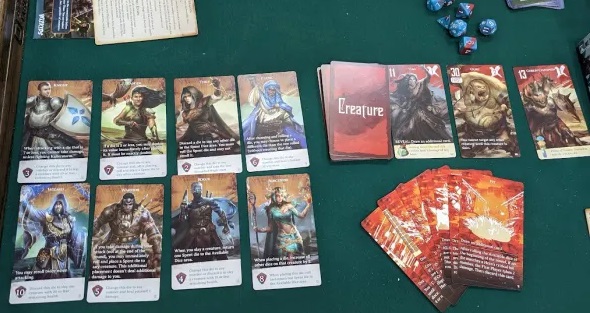 Dice Conquest is a small card and dice game at a fairly small price point (only $20 but you also get a set of RPG dice.) 1 to 4 players cooperatively try to make it through a deck of creature cards and then defeat the final boss. At the start of a round, all the dice are rolled and then players take turns using one of the dice to power one of their own abilities (there are 8 unique characters to choose from.) Every character has a passive ability and an active ability (that would need to be powered by a die.) Players damage any active enemy creatures, eliminating them once their health runs out. At the end of a round, any partially damaged creatures heal up, the dice are rolled, and another round begins. It’s a quick little game that works well solo as well as with a few friends (although I’d suggest playing with 2 characters if trying it solo as making it with a single character can be pretty rough…)
Dice Conquest is a small card and dice game at a fairly small price point (only $20 but you also get a set of RPG dice.) 1 to 4 players cooperatively try to make it through a deck of creature cards and then defeat the final boss. At the start of a round, all the dice are rolled and then players take turns using one of the dice to power one of their own abilities (there are 8 unique characters to choose from.) Every character has a passive ability and an active ability (that would need to be powered by a die.) Players damage any active enemy creatures, eliminating them once their health runs out. At the end of a round, any partially damaged creatures heal up, the dice are rolled, and another round begins. It’s a quick little game that works well solo as well as with a few friends (although I’d suggest playing with 2 characters if trying it solo as making it with a single character can be pretty rough…)
Kites (Floodgate Games – $20) 2-6p 10 min 10+
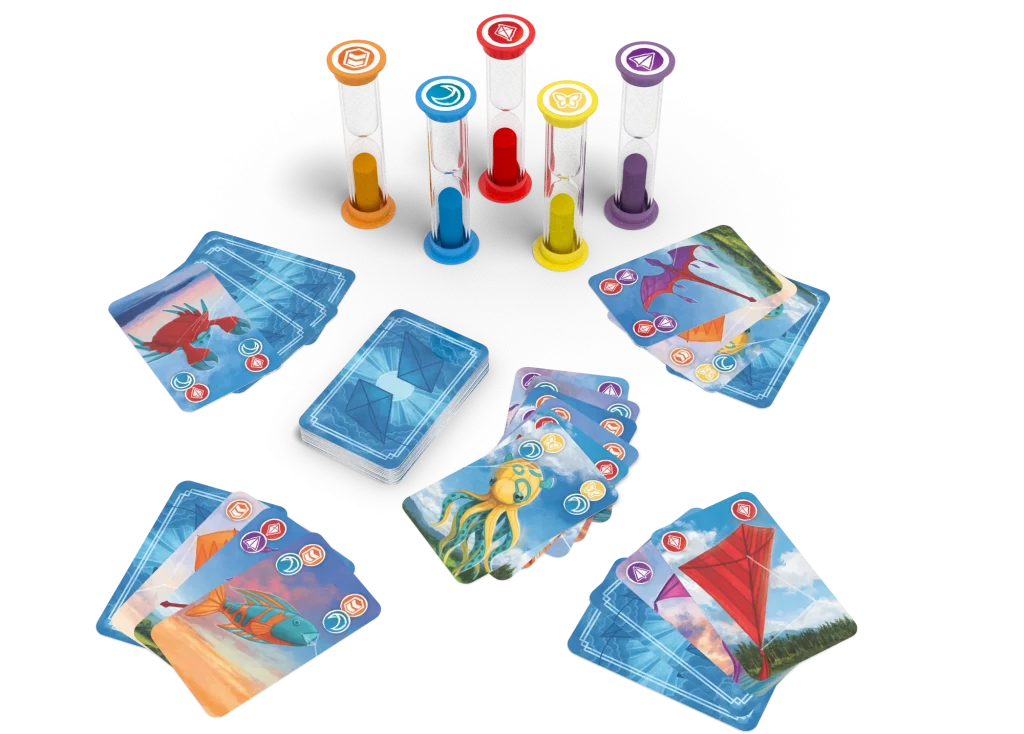 In Kites, players are cooperating to keep their kites in the air and not let them fall. It is a speed card game based on flipping timers. Each player has a hand of cards and players take turns playing any card from their hand (displaying one or two colors) and then drawing a new card. When a card is played, the active player flips all the timers that match colors on the cards. The goal is for the players to keep all the timers running without stopping. To add a bit of chaos to the mix, there is a “wildcard” timer that is also going. It can be flipped by any color, but only by cards displaying a single color. Speed is key to keeping things going, but planning ahead is also necessary to try and stay ahead of the march of (sand)time(rs).
In Kites, players are cooperating to keep their kites in the air and not let them fall. It is a speed card game based on flipping timers. Each player has a hand of cards and players take turns playing any card from their hand (displaying one or two colors) and then drawing a new card. When a card is played, the active player flips all the timers that match colors on the cards. The goal is for the players to keep all the timers running without stopping. To add a bit of chaos to the mix, there is a “wildcard” timer that is also going. It can be flipped by any color, but only by cards displaying a single color. Speed is key to keeping things going, but planning ahead is also necessary to try and stay ahead of the march of (sand)time(rs).
Marvel: Remix (Wizkids – $20) 2-6p 20 min 12+
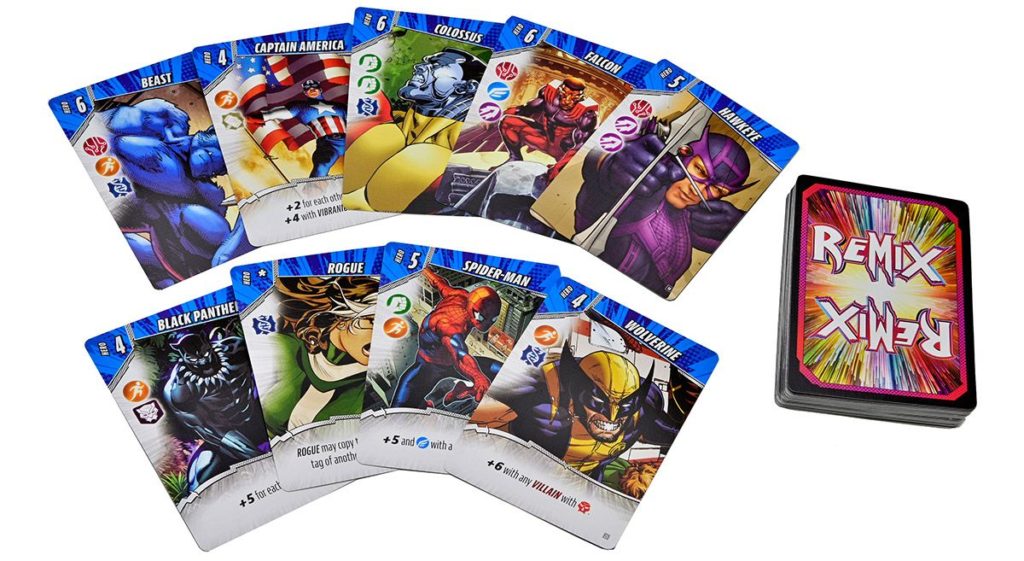 Marvel: Remix is a short card-collecting game where players try to accumulate sets of hero cards to score points. However, unlike games like Rummy, the collected cards also decide how a player scores. One player may be gaining points for lots of villains while another scores points for each X-Men in their hand. Players take turns drawing from a central deck or they may pick up cards from the discard pile. After a set number of cards appear in the discard pile, the game ends. Games are pretty quick, so picking solid synergistic scoring goals early on is important and if you don’t get that last one or two perfect cards before the game ends, it’s a quick game – just give it another go.
Marvel: Remix is a short card-collecting game where players try to accumulate sets of hero cards to score points. However, unlike games like Rummy, the collected cards also decide how a player scores. One player may be gaining points for lots of villains while another scores points for each X-Men in their hand. Players take turns drawing from a central deck or they may pick up cards from the discard pile. After a set number of cards appear in the discard pile, the game ends. Games are pretty quick, so picking solid synergistic scoring goals early on is important and if you don’t get that last one or two perfect cards before the game ends, it’s a quick game – just give it another go.
Cat in the Box:Deluxe Version (Bézier Games – $30) 2-5p 20-20 min 13+
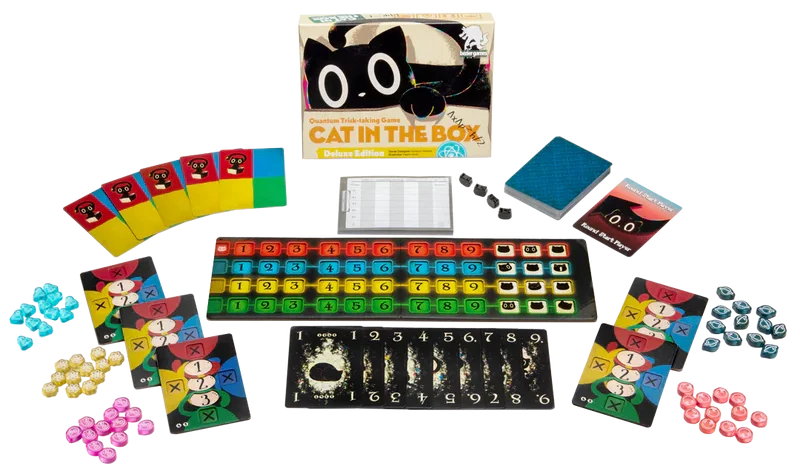 Cat in the Box has been out for awhile, but its deluxe edition is now available. Cat in the Box is a trick-taking game where suit and value are determined separately. Players first predict how many tricks they will take and then play out the hand. The lead player places a card and declares its color, marking it on the central board. Other players must follow with cards that are declared yellow. However, a player can declare they’re out of yellow and thus play another color. The trick, of course, is that the game tracks how players are going and they may back themselves into a corner near the end of a hand, with nothing valid to play (because their cards and colors they declared were out.) This causes a “paradox” which stops the hand and players score points. The paradox-causing player doesn’t just fail to score, they are also assigned penalty points. The game plays for 3-4 players and lasts a number of rounds equal to the player count.
Cat in the Box has been out for awhile, but its deluxe edition is now available. Cat in the Box is a trick-taking game where suit and value are determined separately. Players first predict how many tricks they will take and then play out the hand. The lead player places a card and declares its color, marking it on the central board. Other players must follow with cards that are declared yellow. However, a player can declare they’re out of yellow and thus play another color. The trick, of course, is that the game tracks how players are going and they may back themselves into a corner near the end of a hand, with nothing valid to play (because their cards and colors they declared were out.) This causes a “paradox” which stops the hand and players score points. The paradox-causing player doesn’t just fail to score, they are also assigned penalty points. The game plays for 3-4 players and lasts a number of rounds equal to the player count.
Special Mention – Solo Play:
With the pandemic limiting gamers’ opportunities to meet together, the realm of solo gaming (playing a boardgame solo) has been on the rise. Traditionally the realm of a dedicated wargamer, there is now a large breadth of solo games available. Many games come with solo rules but a few are designed specifically for solo play.
Warp’s Edge (Renegade Game Studios – $35) 1p 30-45 min 10+ yrs
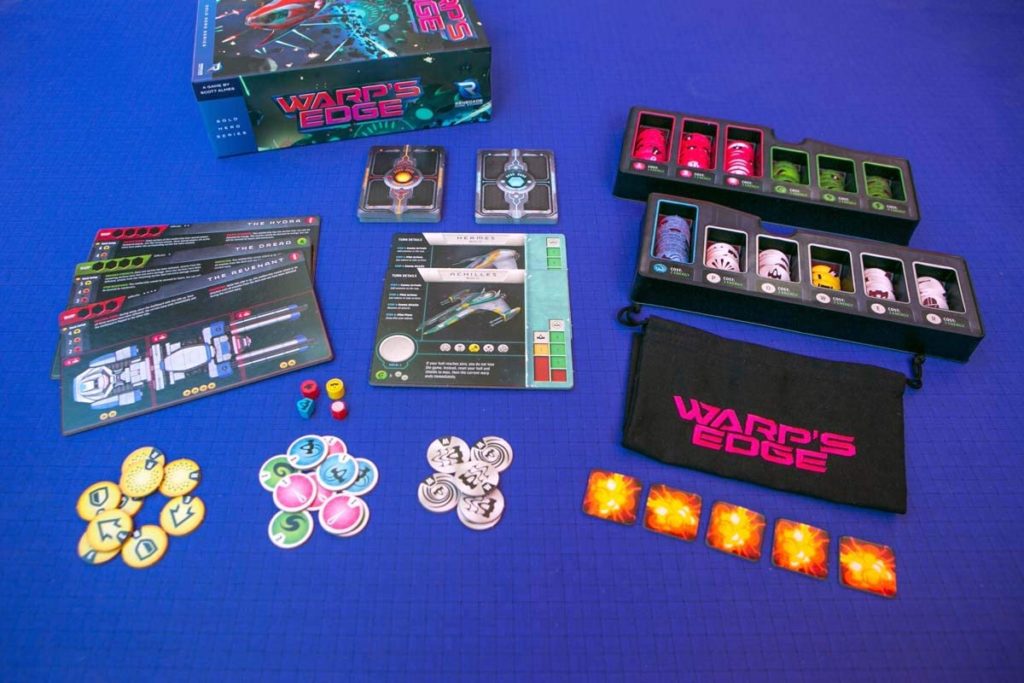 Warp’s Edge is a solo (obviously) bag-building game of spaceships and alien invasion. Starting with a specific ship (players get to choose, all with slightly different abilities) players create a bag full of a few special chips and set up a small library of additional chips that can be purchased. The heart of the game revolves around revealing enemy ships and then drawing chips from one’s bag to activate abilities and defeat them. Defeating ships rewards one with additional chip draws, repairing your ship, and often the chance to add new chips to your bag. Running out of chips simply causes a game reset with all of one’s chips put back into the bag. Thus, each “run” will be more powerful than the last. Defeating enough of the enemy’s fighter ships will allow a player to attack the main villain, the mothership. Defeat her(?) to win the game. Meanwhile, the game is immediately lost if one’s ship explodes, or fails to defeat the mothership after a set number of runs through the chip bag. With a variety of player ships and motherships with which to mix and match the game has a good amount of variety. There is even a sort of choose-your-own-adventure storybook that can guide one through a series of battle setups but I’ve found plenty to explore in simple one-off battles. There are two expansions available, Viren Invasion has 2 new ships, 2 new motherships, and a variety of additional options. The newest, Anomaly, should be in stores soon. It also has 2 new ships and motherships, a way to modify the difficulty of all the motherships, and a special Anomaly bag. Chips from this bag are drawn from time to time and provide drawbacks or benefits – something new to which the player has to respond.
Warp’s Edge is a solo (obviously) bag-building game of spaceships and alien invasion. Starting with a specific ship (players get to choose, all with slightly different abilities) players create a bag full of a few special chips and set up a small library of additional chips that can be purchased. The heart of the game revolves around revealing enemy ships and then drawing chips from one’s bag to activate abilities and defeat them. Defeating ships rewards one with additional chip draws, repairing your ship, and often the chance to add new chips to your bag. Running out of chips simply causes a game reset with all of one’s chips put back into the bag. Thus, each “run” will be more powerful than the last. Defeating enough of the enemy’s fighter ships will allow a player to attack the main villain, the mothership. Defeat her(?) to win the game. Meanwhile, the game is immediately lost if one’s ship explodes, or fails to defeat the mothership after a set number of runs through the chip bag. With a variety of player ships and motherships with which to mix and match the game has a good amount of variety. There is even a sort of choose-your-own-adventure storybook that can guide one through a series of battle setups but I’ve found plenty to explore in simple one-off battles. There are two expansions available, Viren Invasion has 2 new ships, 2 new motherships, and a variety of additional options. The newest, Anomaly, should be in stores soon. It also has 2 new ships and motherships, a way to modify the difficulty of all the motherships, and a special Anomaly bag. Chips from this bag are drawn from time to time and provide drawbacks or benefits – something new to which the player has to respond.
Of course, all through this guide were games that ran from 1 to more players. Dice Conquest and Dinosaur Island: Rawr ‘n Write are both easily played solo. Tiny Epic Dungeons, Return to Dark Tower, and Dice Throne Adventures also work well – better if one plays with two characters at once. Horizons of Spirit Island is a tougher call. One can certainly play solo with a single spirit but that is often more difficult than a larger 2-spirit game. However, the mental overhead of running two separate spirits in Spirit Island is not for the faint of heart. Starship Captains does provide a sort of AI (via cards) driven opponent ship for solo play but I have not yet been able to bring it to the table. A solo mode for Agents of Mayhem is rumored for the future but has not yet been released.
Conclusions
No matter what toys and presents the holidays bring, be sure to keep time in your schedule for playing with friends and family. While the games here come highly recommended to provide fun for a wide range of players, there are plenty other choices available. Ask your local game store, a boardgaming friend, or check some of our past recommendations.
*Disclaimer, some of these games were provided by the publishers for review purposes. Of course, there were plenty other games provided who didn’t make the cut.





Discussion Area - Leave a Comment